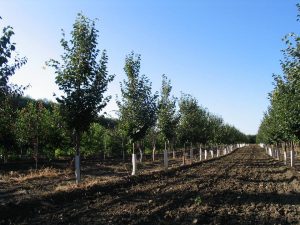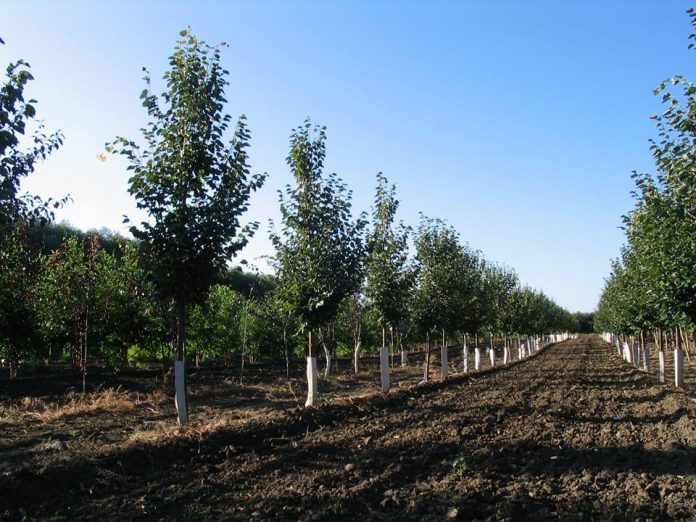
At the center of the Flower Mound town logo is a tree with a large, leafy canopy. During the May 4th Town Council meeting, problems with the current Tree Ordinance– and possible solutions for the future of the town’s trees– were discussed by council members, town staff and residents.
The town’s trees are part of the 150-mile Cross Timbers woodland region that runs north and south from north central Texas up through Oklahoma and Kansas. In 2014, the town celebrated its re-certification as a “Tree City USA” by the Arbor Day Foundation for the 20th consecutive year. Flower Mound is one of only 77 municipalities in Texas to earn this honor.
Long-time resident and Environmental Conservation Commission (ECC) member Alton Bowman started the tree discussion by highlighting problems involving the exemption for mitigation in the town’s Special Plan Area (SPA) Developments; especially in the approximately 1,465 acre Tax Increment Reinvestment Zones (TIRZ) along the FM 2499 corridor. The TIRZ were created in 2005 to provide funds for public infrastructure and proposed improvement projects over a 20-year period.
The tree ordinance states that if a specimen tree is removed, for example a 20-caliper inch tree, double the number of caliper inches have to be used to replace it; therefore, 40-caliper inches divided by a 3-caliper inch replacement trees means that 13 new trees would be planted. For a protected tree, replacement must be one-for-one caliper inches. In SPA commercial developments, those mitigation requirements do not apply.
Bowman said that each year the number of trees not planted, because of the exemptions, is approximately 500 trees. Construction permit applicants outside a SPA can either plant trees or give the town $375 for each tree. In the SPA-exempt acres, last year’s un-planted trees or lost revenue equaled $187,000 to the tree fund. Over the 14-year span of time that the mitigation has been in place, either 7,000 trees would have been planted, or the town would have received $2,400,000 for the tree fund.
Town Manager Jimmy Stathatos said that an estimated 460 trees would have to be added due to mitigation if the property was not in an exempt area in 2013, but there were 2,286 trees planted because of mitigation and another 1,108 trees planted because of the town’s landscape requirements.
The town’s original Tree Ordinance was created in 2000 and amended in 2008. Bowman said that a re-examination of the current ordinance should address the exemption for mitigation problem. He also recommended forming a plan to deal with slow-growing Post Oak trees; some of which can live for 200- to 300-years, but their root systems make them extremely sensitive.
Environmental Services Director Matthew Woods reported that the town staff was looking at the SPA exemption for mitigation policy and its impact on the town’s present tree farm. Started in 2011, the current farm is on under one-third of an acre and consists of about 40 trees in above-ground containers.
He added that a sustainability tree plan is under consideration, but the staff is waiting for recommendations from the ECC. Commissioners are waiting for the results from a new survey of the town’s tree canopy; that survey requires new software, which the town has yet to purchase.
In its April meeting, council member Mike Walker had asked the council to consider amending the mitigation exemption section of the current Tree Ordinance. He has been actively working on plans for sustainability and preservation of the town’s trees during the past year.
The “Walker Plan” includes reviewing the SPA’s limited tree mitigation and fully implementing the other sections of the Tree Ordinance. It also seeks to relocate and expand the existing tree farm and possibly included a tree bank to allow the town to distribute trees to residents to transplant and grow the town’s canopy every year as part of Arbor Day celebrations (the first weekend in November in Texas).
Walker has also raised the alternative of “incentivizing” developers to mold their developments around specimen trees, rather than only penalizing them for removing those special trees.
“Re-classifying some tree species—such as the old-growth Post Oaks—could also help solve some of the town’s tree issues,” said Walker.
Woods added that maintaining, or creating, tree “islands” on slopes or elevations un-hospitable for construction could also preserve or expand the town’s tree canopy.
“A new location for the tree farm and bank could also include an education center about local trees and the [Cross Timbers] history,” said Walker.
Council member Bryan Webb requested that the town’s tree issues and protocols be added to the agenda items to be discussed at the upcoming council strategy meeting.
The next ECC regular meeting is scheduled for June 2. Commissioners are: Craig Bromley, chair; Ellen Stallcup, Place 2; Russell McNamer, Vice Chair; Marilyn Lawson, Place 4; Alton Bowman, Place 5; Jennifer Romaszewski, Place 6; Joe Haver, Place 7; Carol Kohankie, Place 8, Alternate; James Gerber, Place 9, Alternate; and, Jim Cumbest, Place 10, Alternate.





 GIF.gif)











